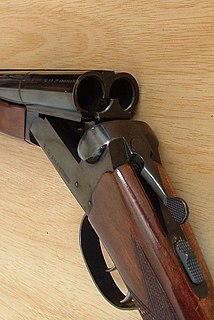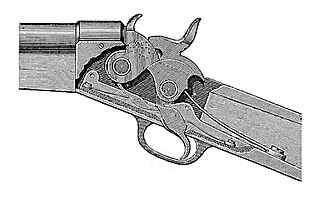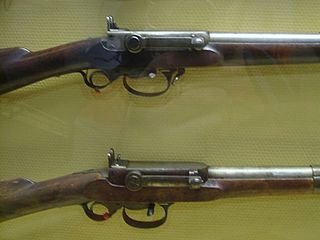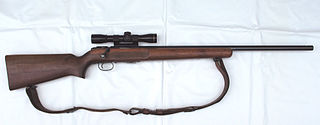
Single-shot firearms are firearms that hold only a single round of ammunition, and must be reloaded manually after every shot. The history of firearms began with single-shot designs, then multi-barreled designs appeared, and eventually many centuries passed before multi-shot repeater designs became commonplace.

In firearms terminology, an action is the functional mechanism of a breech-loading firearm that handles the ammunition cartridges, or the method by which that mechanism works. Actions are technically not present on muzzleloaders, as all those are single-shot firearms with a closed off breech with the powder and projectile manually loaded from the muzzle. Instead, the muzzleloader ignition mechanism is referred to as the lock.

The M1903 Springfield, officially the United States Rifle, Caliber .30-06, Model 1903, is an American five-round magazine-fed, bolt-action service repeating rifle, used primarily during the first half of the 20th century.
The term Springfield rifle may refer to any one of several types of small arms produced by the Springfield Armory in Springfield, Massachusetts, for the United States armed forces.
The Springfield Armory M1A is a semi-automatic rifle made by Springfield Armory, Inc., beginning in 1974, based on the M14 rifle, for the civilian and law enforcement markets in the United States. "M1A" is a proprietary name for Springfield Armory's M14-pattern rifle. Early M1A rifles were built with surplus G.I. parts until Springfield Armory, Inc. began manufacturing their own.

The ArmaLite AR-10 is a 7.62×51mm NATO battle rifle designed by Eugene Stoner in the late 1950s and manufactured by ArmaLite. When first introduced in 1956, the AR-10 used an innovative straight-line barrel/stock design with phenolic composite and forged alloy parts resulting in a small arm significantly easier to control in automatic fire and over 1 lb (0.45 kg) lighter than other infantry rifles of the day. Over its production life, the original AR-10 was built in relatively small numbers, with fewer than 10,000 rifles assembled. However, the ArmaLite AR-10 would become the progenitor for a wide range of firearms.

The Remington M1867 was a rolling-block rifle, the first rifle using metallic cartridges to be adopted by the Norwegian and Swedish armies. Nominally it had a caliber of 4 decimal lines, but the actual caliber was 3.88 Norwegian decimal lines or 4.1 Swedish decimal lines (12.17 mm), and it fired a rimfire round with a 12.615 mm lead bullet. The 12.17 mm caliber was chosen because the Swedish army had approximately 30,000 new muzzle-loading M1860 and breech-loading M1864 rifles in 12.17 mm caliber in stock, rifles that were suitable for conversion to M1867 rolling-block rifles. With the exception of the first 10,000 rifles and 20,000 actions, which were made by Remington in the US, all Remington M1867 rifles and carbines were made under license in Norway and Sweden, by Kongsberg Vaapenfabrik in Norway, and by Husqvarna Vapenfabriks Aktiebolag and Carl Gustafs stads Gevärsfaktori in Sweden with the two Swedish manufacturers producing about 80% of the weapons.

A rolling-block action is a form of firearm action where the sealing of the breech is done with a specially shaped breechblock able to rotate on a pin. The breechblock is shaped like a section of a circle. The breechblock is locked into place by the hammer, thus preventing the cartridge from moving backwards at the moment of firing. By cocking the hammer, the breechblock can be rotated freely to reload the weapon.

The Kammerlader, or "chamber loader", was the first Norwegian breech-loading rifle, and among the first breech loaders adopted for use by an armed force anywhere in the world. A single-shot black-powder rifle, the kammerlader was operated with a crank mounted on the side of the receiver. This made it much quicker and easier to load than the weapons previously used. Kammerladers quickly gained a reputation for being fast and accurate rifles, and would have been a deadly weapon against massed ranks of infantry.

The M1917 Enfield, the "American Enfield", formally named "United States Rifle, cal .30, Model of 1917" is an American modification and production of the .303-inch Pattern 1914 Enfield (P14) rifle, which was developed and manufactured during the period 1917–1918. Numerically, it was the main rifle used by the American Expeditionary Forces in Europe during World War I. The Danish Sirius Dog Sled Patrol on Greenland still use the M1917, which performs reliably in Arctic conditions, as their service weapon.

The Pedersen Rifle, officially known in final form as the T1E3 rifle, was a United States semi-automatic rifle designed by John Pedersen that was made in small numbers for testing by the United States Army during the 1920s as part of a program to standardize and adopt a replacement for the M1903 Springfield.

Remington Rolling Block is a family of breech-loading rifles that was produced from the mid-1860s into the early 20th century by E. Remington and Sons. The action was extremely strong, and could easily withstand the increased pressure of the new smokeless powders coming into use by the late 1880s.

The Springfield Model 1865 was an early breech-loading rifle manufactured by U.S. Armory in Springfield, Massachusetts. It was a modification of the Springfield Model 1861. It was later replaced with the Springfield Model 1866.

The Springfield Model 1870 was one of the rifles which used the trapdoor breechblock design developed by Erskine S. Allin. The Model 1870 was a minor improvement to the Springfield Model 1868, and retained most of the Model 1868 rifle features.

The Springfield Model 1868 was one of the rifles which used the trapdoor breechblock design developed by Erskine S. Allin.

The Springfield model 1871 rolling-block U.S. Army rifle was manufactured in 1871–72 by Springfield Armory, using the design originated by Remington Arms Company, under a royalty agreement.

The Remington Model 513 Matchmaster is a bolt-action rifle, manufactured from 1940 to 1968. Since the rifle was designed for target shooting, it came equipped with a sturdy half stock with sling swivels, a beavertail fore end, and a straight comb which rose at the heel. Matchmaster barrels were a 27" heavy target semi-floating type. The patented Matchmaster trigger mechanism had an adjustable stop. The Matchmaster was made to fire only the .22-caliber Long Rifle cartridge from a detachable magazine. Civilian versions of the Matchmaster have a blued finish, while those made for U.S. Army and ROTC service can have either a blued or a parkerized finish.
The Winchester Hotchkiss was a bolt-action repeating rifle patented by Benjamin B. Hotchkiss in 1876 and produced by the Winchester Repeating Arms Company and Springfield Armory from 1878. The Hotchkiss, like most early bolt-actions, had a single rear locking lug integral with the bolt handle, but was unique in feeding multiple rounds from a tubular buttstock magazine similar to the Spencer rifle. The .45-70 Hotchkiss was acquired in limited numbers by the US Navy as the M1879, and by the US Army and several state militias as the M1883, making it the first center-fire bolt-action repeater to be adopted by any major military.
The term Joslyn Rifle refers to a series of rifles produced in the mid-19th century. The term is often used to refer specifically to the Joslyn Model 1861/1862, which was the first mass-produced breech-loading rifle produced at the Springfield Armory.

In firearms, a trapdoor is a form of breech-loading mechanism for rifles in which a hinged breechblock rotates up and forward, resembling the movement of a trapdoor. The Springfield models 1865 and 1873 were best known for first employing this type of action.















